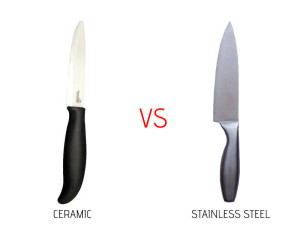Kitchen Knives Ceramic Vs Steel
A question that many people ask me all the time, and like all questions it’s not a stupid one!
Both of these knife types come with their own pros and cons, handle differently and have their own uses in the everyday kitchen.
Let’s start with the traditional Steel knife.
Steel Knives:
These come in many guises and styles by different makers and as with everything in life you get what you pay for as the old saying goes.
My preference in this type of knife is to choose one for each job in your kitchen
For example if I want to peel and cut small vegetables then I choose a knife with a blade of no more than 3 inches and if I am wanting to cut through large pieces of meat with bone or a chicken then go for a heavy knife with a blade no shorter than 10 inches.
I like stainless steel because of its ability to not stain with acid type foods and I like the blade “tang” to be a part of the handle and not just glued into it. (the tang is one piece with the blade that is visible through the handle)
If you choose steel knives look for a product that uses either German steel or Japanese as in my opinion these are the best providers of good quality steel.
Sharpen them every 2- 3 uses with a traditional steel and the knife should give you years of use. I have several knives in use that I purchased in the 1960’s that I would not be without.
If the blade dulls have the knife ground by a professional or run it over an oil or water stone to revive the knife edge.
>> Click here to see reviews, ratings, specifications and prices on Amazon <<
Ceramic Knives:
Ceramic knives are a great addition to a knife set as they provide the user with a non staining blade and a blade that stays sharp without constant sharpening.
The downside of these knives are that they are very fragile and will break if dropped on a hard surface and they are very light which makes them not suitable for chopping bones as the blades will chip.
I use ceramic knives when preparing a lot of acidic fruits and for very light duty applications.
Ceramic vegetable peelers are great and are always my first choice.
Though some manufacturers say their ceramic knives can be washed in a dishwasher, most recommend hand washing – if you don’t want to risk your ceramic knife becoming chipped or damaged handwashing would be the best option.
>> Click here to see reviews, ratings, specifications and prices on Amazon <<
What Kitchen Knives Do You Really Need?
In summing up I would suggest to anyone looking to purchase new knives, don’t go for the cheapest but look for quality. For a starter set I would choose the following
- 1 x 10 – 12 inch chef’s knife
- 1 x 7 – 8 inch general purpose (like a smaller chef’s knife)
- 1 x 3 – 4 inch vegetable
- 1 serrated bread knife
- 1 x 14 -16 inch carving knife
As with all knives – how you look after them with determine their overall lifespan. Many of the modern best kitchen knives are made from high quality stainless steel. You will find that handwashing and drying your knife after every use will ensure that your kitchen knives last for many years.
Kindly Contributed by Chef Mike Morphew M.C.F.A.

